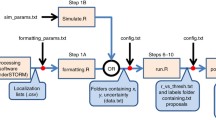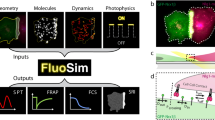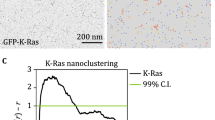Abstract
Cell membranes display a range of receptors that bind ligands and activate signaling pathways. Signaling is characterized by dramatic changes in membrane molecular topography, including the co-clustering of receptors with signaling molecules and the segregation of other signaling molecules away from receptors. Electron microscopy of immunogold-labeled membranes is a critical technique to generate topographical information at the 5–10 nm resolution needed to understand how signaling complexes assemble and function. However, due to experimental limitations, only two molecular species can usually be labeled at a time. A formidable challenge is to integrate experimental data across multiple experiments where there are from 10 to 100 different proteins and lipids of interest and only the positions of two species can be observed simultaneously. As a solution, we propose the use of Markov random field (MRF) modeling to reconstruct the distribution of multiple cell membrane constituents from pair-wise data sets. MRFs are a powerful mathematical formalism for modeling correlations between states associated with neighboring sites in spatial lattices. The presence or absence of a protein of a specific type at a point on the cell membrane is a state. Since only two protein types can be observed, i.e., those bound to particles, and the rest cannot be observed, the problem is one of deducing the conditional distribution of a MRF with unobservable (hidden) states. Here, we develop a multiscale MRF model and use mathematical programming techniques to infer the conditional distribution of a MRF for proteins of three types from observations showing the spatial relationships between only two types. Application to synthesized data shows that the spatial distributions of three proteins can be reliably estimated. Application to experimental data provides the first maps of the spatial relationship between groups of three different signaling molecules. The work is an important step toward a more complete understanding of membrane spatial organization and dynamics during signaling.
Similar content being viewed by others
References
Andrews, N.L. et al., 2007. Dynamics, topography, and microdomains in FcεRI signaling. Biophys. J., submitted.
Barisas, B.G. et al., 2007. Compartmentalization of the Type I Fc epsilon receptor and MAFA on mast cell membranes. Biophys. Chem. 126, 209–217.
Berlin, R.D. et al., 1974. Control of cell surface topography. Nature 247, 45–46.
Besag, J., 1974. Spatial interaction and the statistical analysis of lattice systems. J. Roy. Stat. Soc. Ser. B 36(2), 192–236.
Besag, J., 1986. On the statistical analysis of dirty pictures. J. Roy. Stat. Soc. Ser. B 48(3), 259–302.
Bouman, C.A., Shapiro, M., 1994. A multiscale random field model for Bayesian image segmentation. IEEE Trans. Image Process. 3(2), 162–177.
Celeux, G., Forbes, F., Peyrard, N., 2003. EM procedures using mean field-like approximations for Markov model-based image segmentation. Pattern Recognit. 36(1), 131–144.
Chalmond, B., 1989. An iterative Gibbsian technique for reconstruction of M-ary images. Pattern Recognit. 22(6), 747–762.
Cross, G.R., Jain, A.K., 1983. Markov random field texture models. IEEE Trans. Pattern Anal. Mach. Intell. 5(1), 25–39.
Dempster, A.P., M. Laird, N., Rubin, D.B., 1977. Maximum likelihood from incomplete data via the EM algorithm. J. Roy. Stat. Soc. Ser. B 39(1), 1–38.
Derin, H., Elliott, H., 1987. Modeling and segmentation of noisy and textured images using Gibbs random fields. IEEE Trans. Pattern Anal. Mach. Intell. 9(1), 39–55.
Efros, A.A., Leung, T.K., 1999. Texture synthesis by non-parametric sampling. In: ICCV ’99: Proceedings of the International Conference on Computer Vision, vol. 2, p. 1033, Washington, DC, USA. IEEE Computer Society.
Geman, S., Geman, D., 1984. Stochastic relaxation, Gibbs distributions, and the Bayesian restoration of images. IEEE Trans. Pattern Anal. Mach. Intell. 6(6), 721–741.
Gill, P.E., Murray, W., Saunders, M.A., 2002. SNOPT: an SQP algorithm for large-scale constrained optimization. SIAM J. Optim. 12(4), 979–1006.
Gurelli, M.I., Onural, L., 1994. On a parameter estimation method for Gibbs–Markov random fields. IEEE Trans. Pattern Anal. Mach. Intell. 16(4), 424–430.
Hancock, J.F., Prior, I.A., 2005. Electron microscopic imaging of ras signaling domains. Methods 37(2), 165–712.
Hernandez-Sanchez, B.A. et al., 2006. Synthesizing biofunctionalized nanoparticles to image cell signaling pathways. IEEE Trans. NanoBiosc. 5, 222–230.
Kato, Z., Berthod, M., Zerubia, J., 1996. A hierarchical Markov random field model and multitemperature annealing for parallel image classification. CVGIP: Graph. Model Image Process. 58(1), 18–37.
Kato, Z., Zerubia, J., Berthod, M., 1999. Unsupervised parallel image classification using Markovian models. Pattern Recognit. 32(4), 591–604.
Kim, J.H. et al., 2005. Independent trafficking of Ig-α/Ig-β and μ-heavy chain is facilitated by dissociation of the B cell antigen receptor complex. J. Immunol. 175, 147–154.
Laferté, J.M., Pérez, P., Heitz, F., 2000. Discrete Markov image modeling and inference on the quadtree. IEEE Trans. Image Process. 9(3), 390–404.
Li, S.Z., 1995. Markov Random Field Modeling in Computer Vision. Springer, London.
Liang, K.H., Tjahjadi, T., 2006. Adaptive scale fixing for multiscale texture segmentation. IEEE Trans. Image Process. 15(1), 249–256.
Lidke, K.A. et al., 2007. Direct observation of membrane proteins confined by actin corrals. J. Cell Biol., submitted.
Mignotte, M. et al., 2000. Sonar image segmentation using an unsupervised hierarchical MRF model. IEEE Trans. Image Process. 9(7), 1216–1231.
Nicolau, D.V. et al., 2006. Identifying optimal lipid raft characteristics required to promote nanoscale protein-protein interactions on the plasma membrane. Mol. Cell Biol. 26, 313–323.
Oliver, J.M. et al., 2004. Membrane receptor mapping: the membrane topography of FcεRI signaling. In: P. Quinn (Ed.), Membrane Dynamics and Domains, Subcellular Biochemistry, vol. 37. Kluwer Academic/Plenum, Dordecht/New York, pp. 3–34.
Paget, R., Longstaff, I.D., 1998. Texture synthesis via a noncausal nonparametric multiscale Markov random field. IEEE Trans. Image Process. 7(6), 925–931.
Plowman, S.J. et al., 2005. H-ras, k-ras and inner plasma membrane raft proteins operate in nanoclusters with differential dependence on the actin cytoskeleton. Proc. Natl. Acad. Sci. 102, 15500–15505.
Prior, I.A. et al., 2003. Direct visualization of ras proteins in spatially distinct cell surface microdomains. J. Cell Biol. 160(2), 165–170.
Rabiner, L.R., 1989. A tutorial on hidden Markov models and selected applications in speech recognition. Proc. IEEE 77, 257–286.
Rahman, N.A. et al., 1992. Rotational dynamics of type I Fc epsilon receptors on individually-selected rat mast cells studied by polarized fluorescence depletion. Biophys. J. 61, 334–346.
Seagrave, J.C. et al., 1991. Relationship of IgE receptor topography to secretion in RBL-2H3 mast cells. J. Cell Physiol. 148, 139–151.
Thomas, J.L., Feder, T.J., Webb, W.W., 1992. Effects of protein concentration on IgE receptor mobility in rat basophilic leukemia cell plasma membranes. Biophys. J. 61, 1402–1412.
Tjelmeland, H., Besag, J., 1998. Markov random fields with higher order interactions. Scand. J. Stat. 25, 415–433.
Tonazzini, A., Bedini, L., Salerno, E., 2006. A Markov model for blind image separation by a mean-field EM algorithm. IEEE Trans. Image Process. 15(2), 473–482.
Volna, P. et al., 2004. Negative regulation of mast cell signaling and function by the adaptor lab/ntal. J. Exp. Med. 200(8), 1001–1013.
Wilson, R., Li, C.T., 2003. A class of discrete multiresolution random fields and its application to image segmentation. IEEE Trans. Pattern Anal. Mach. Intell. 25(1), 42–56.
Wilson, B.S., Pfeiffer, J.R., Oliver, J.M., 2000. Observing FcεRI signaling from the inside of the mast cell membrane. J. Cell Biol. 149(5), 1131–1142.
Wilson, B.S. et al., 2001. High resolution mapping of mast cell membranes reveals primary and secondary domains of FcεRI and LAT. J. Cell Biol. 154(3), 645–658.
Wilson, B.S., Pfeiffer, J.R., Oliver, J.M., 2002. FcεRI signaling observed from the inside of the mast cell membrane. Mol. Immun. 38, 1259–1268.
Wilson, B.S. et al., 2004. Markers for detergent-resistant lipid rafts occupy distinct and dynamic domains in native membranes. Mol. Biol. Cell 15(6), 2580–2592.
Xue, M. et al., 2007. FPR and FcεRI occupy common signaling domains for localized crosstalk. Mol. Biol. Cell 18, 1410–1420.
Yang, S. et al., 2007. Mapping ErbB receptors on breast cancer cell membranes during signal transduction. J. Cell Sci. 120, 2763–2773.
Zhang, J., 1992. The mean field theory in EM procedures for Markov random fields. IEEE Trans. Image Process. 40(10), 2570–2583.
Zhang, J., Modestino, J.W., Langan, D.A., 1994. Maximum-likelihood parameter estimation for unsupervised stochastic model-based image segmentation. IEEE Trans. Image Process. 3(4), 404–420.
Zhang, J. et al., 2006. Characterizing the topography of membrane receptors and signaling molecules from spatial patterns obtained using nanometer-scale electron-dense probes and electron microscopy. Micron 37(1), 14–34.
Author information
Authors and Affiliations
Corresponding author
Rights and permissions
About this article
Cite this article
Zhang, J., Steinberg, S.L., Wilson, B.S. et al. Markov Random Field Modeling of the Spatial Distribution of Proteins on Cell Membranes. Bull. Math. Biol. 70, 297–321 (2008). https://doi.org/10.1007/s11538-007-9259-0
Received:
Accepted:
Published:
Issue Date:
DOI: https://doi.org/10.1007/s11538-007-9259-0




